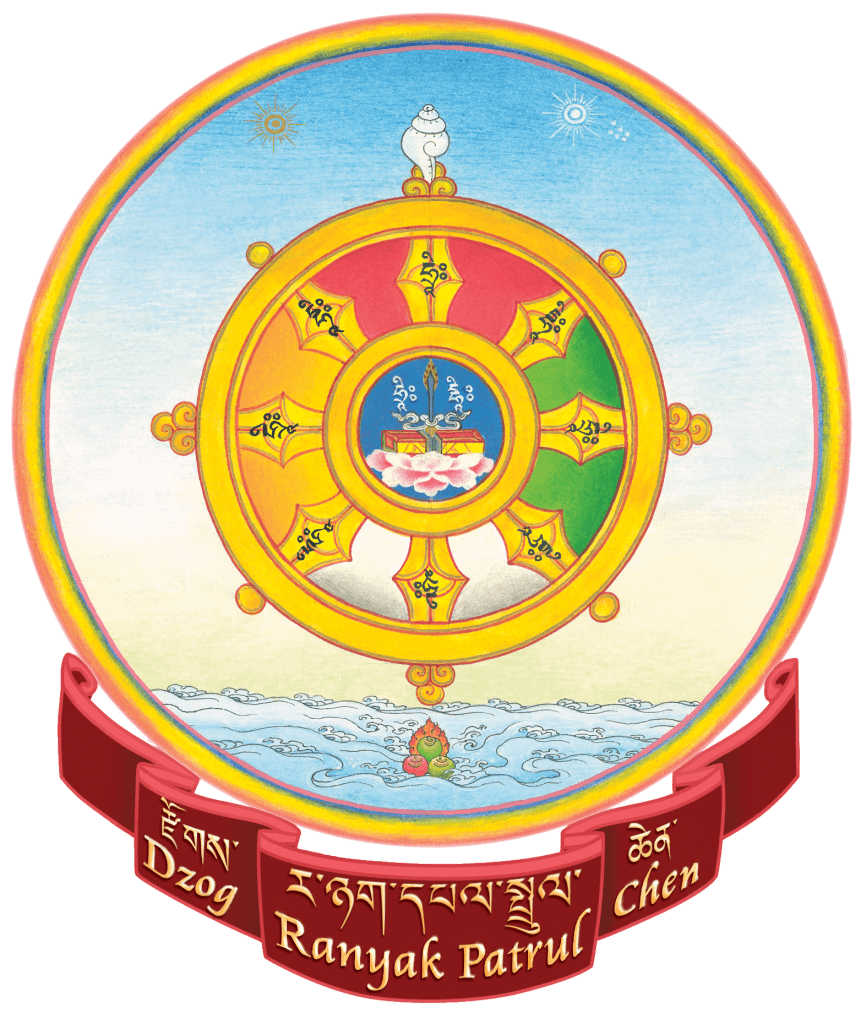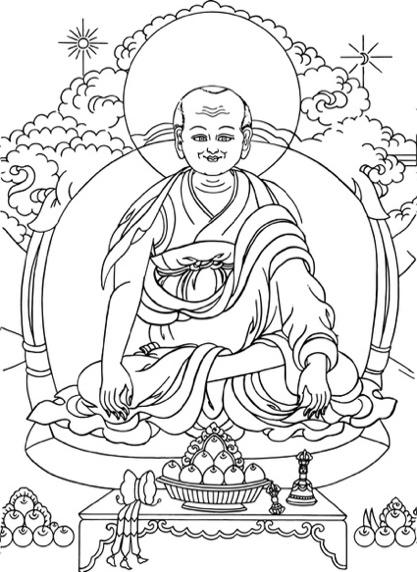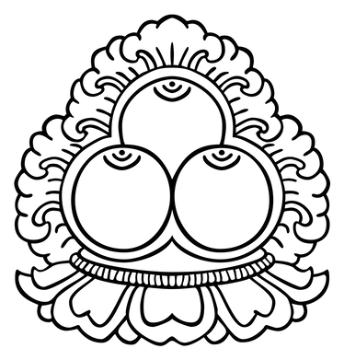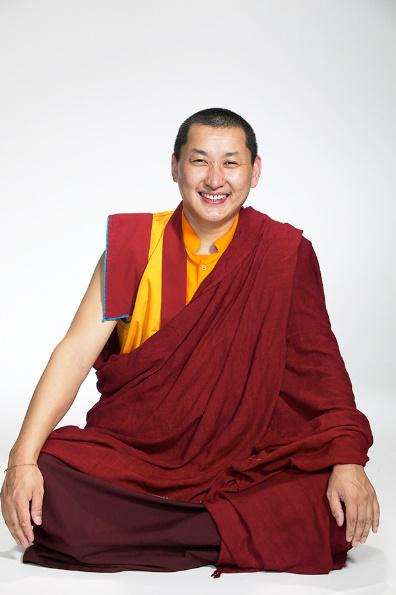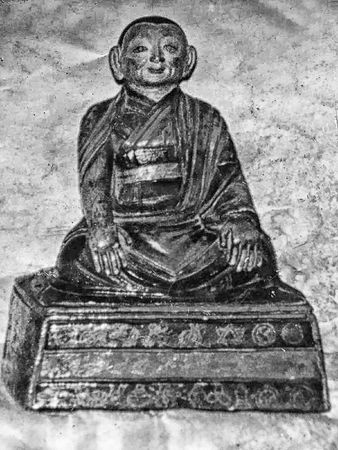Dzogchen Ranyak Patrul Rinpoche est né dans la vallée de Dzogchen en 1963. Il est l’incarnation du grand Dzogchen Patrul Rinpoche, qui était un écrivain, un vagabond et un maître spirituel du 19ème siècle. Deux incarnations suivront avant la naissance de Dzogchen Ranyak Patrul Rinpoche.
Le présent Patrul Rinpoche a parfaitement suivi les traces de ses maîtres. Il a étudié avec certains des maîtres les plus anciens et les plus accomplis de notre époque. Il est entré au monastère de Dzogchen à l’âge de quatorze ans, où il est resté pendant six ans. Il poursuit ensuite ses études à l’université de Śri Siṃha. Il a terminé ses études sans faute, dans un délai que très peu d’étudiants peuvent accomplir. Il a une grande connaissance des tantras et des soutras, à partir de laquelle il peut donner des enseignements sur n’importe quel sujet. Il est détenteur de la précieuse lignée du Longchen Nyingthik. Il donne des enseignements sur cette lignée merveilleuse et profonde et accorde des transmissions de pouvoir.
Patrul Rinpoche est venu en Belgique au printemps 1996. Il a créé des organisations à but non lucratif, une maison d’édition et, au fur et à mesure que les étudiants se rassemblaient autour de lui, il a ouvert plusieurs centres du Dharma à travers l’Europe.
Il n’a cessé d’enseigner et de répandre le Dharma. Il a géré la traduction et la publication d’une grande quantité de textes bouddhistes tibétains. Pendant les étés, il enseigne les études bouddhistes générales et avancées à ses étudiants.
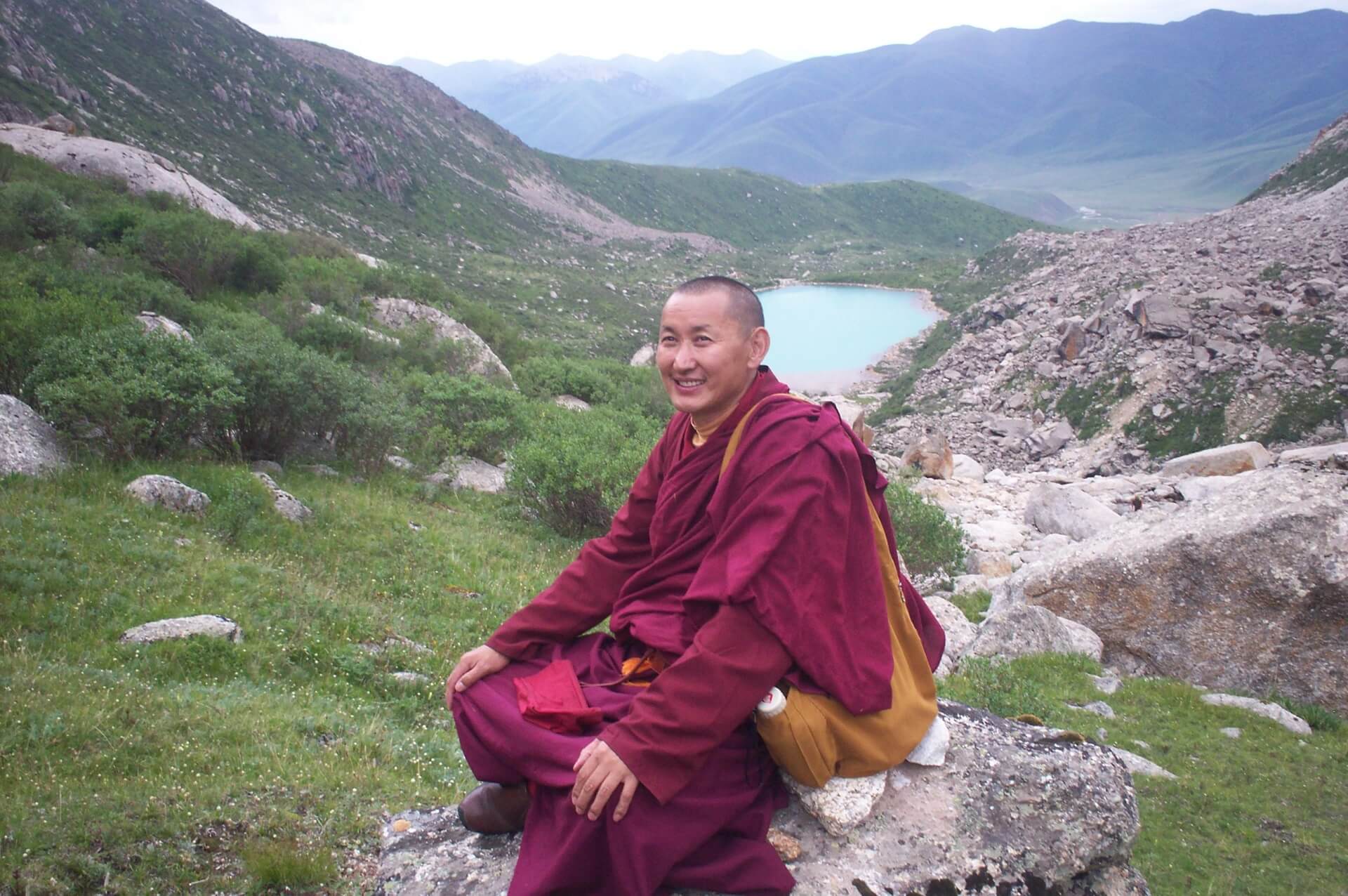
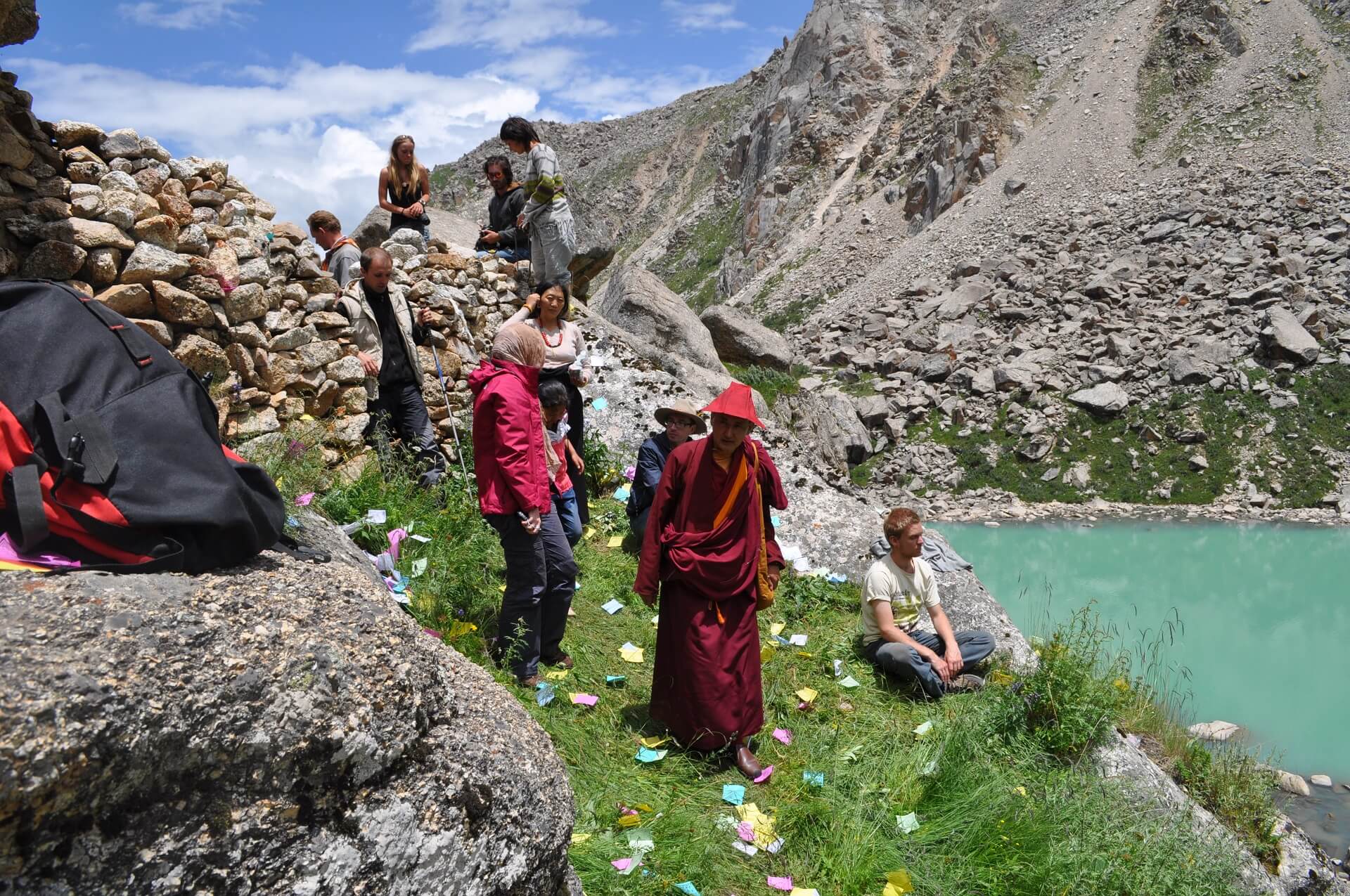
Depuis le début du printemps 2020, il a commencé à donner
beaucoup d’enseignements en ligne, avec des centaines
d’heures d’enseignements disponibles sur le sujet du
‘Chemin de la grande perfection’ et d’autres textes.
De Dzogchen au Tibet
L’incarnation actuelle du grand maître du XIXe siècle, Dzogchen Patrul Rinpoche, est née en 1963 dans les environs du monastère de Dzogchen, Rudam Orgyen Samten Chöling, dans le Kham, au Tibet oriental.
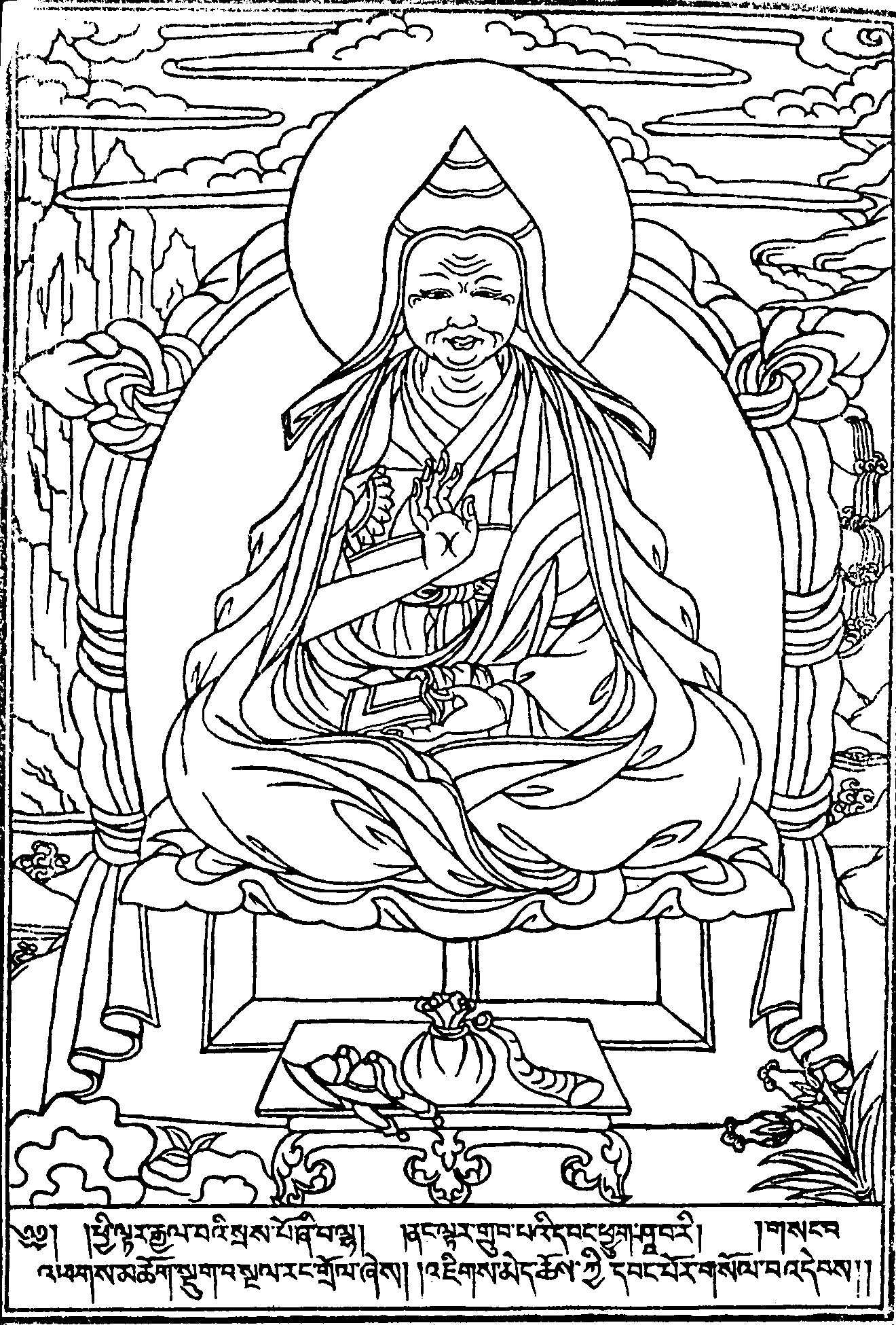
Qui est qui ?
Dzogchen Ranyak Patrul Rinpoche a été reconnu comme la troisième réincarnation du grand Dza Patrul Rinpoche.
Ici une présentation concise des incarnations successives.
Incarnations
Enseignants-racines
« Personne ne peut ramener des joyaux d’une île au trésor
sans s’appuyer sur un navigateur expérimenté.»
Patrul Rinpoche
Le chemin de la grande perfection
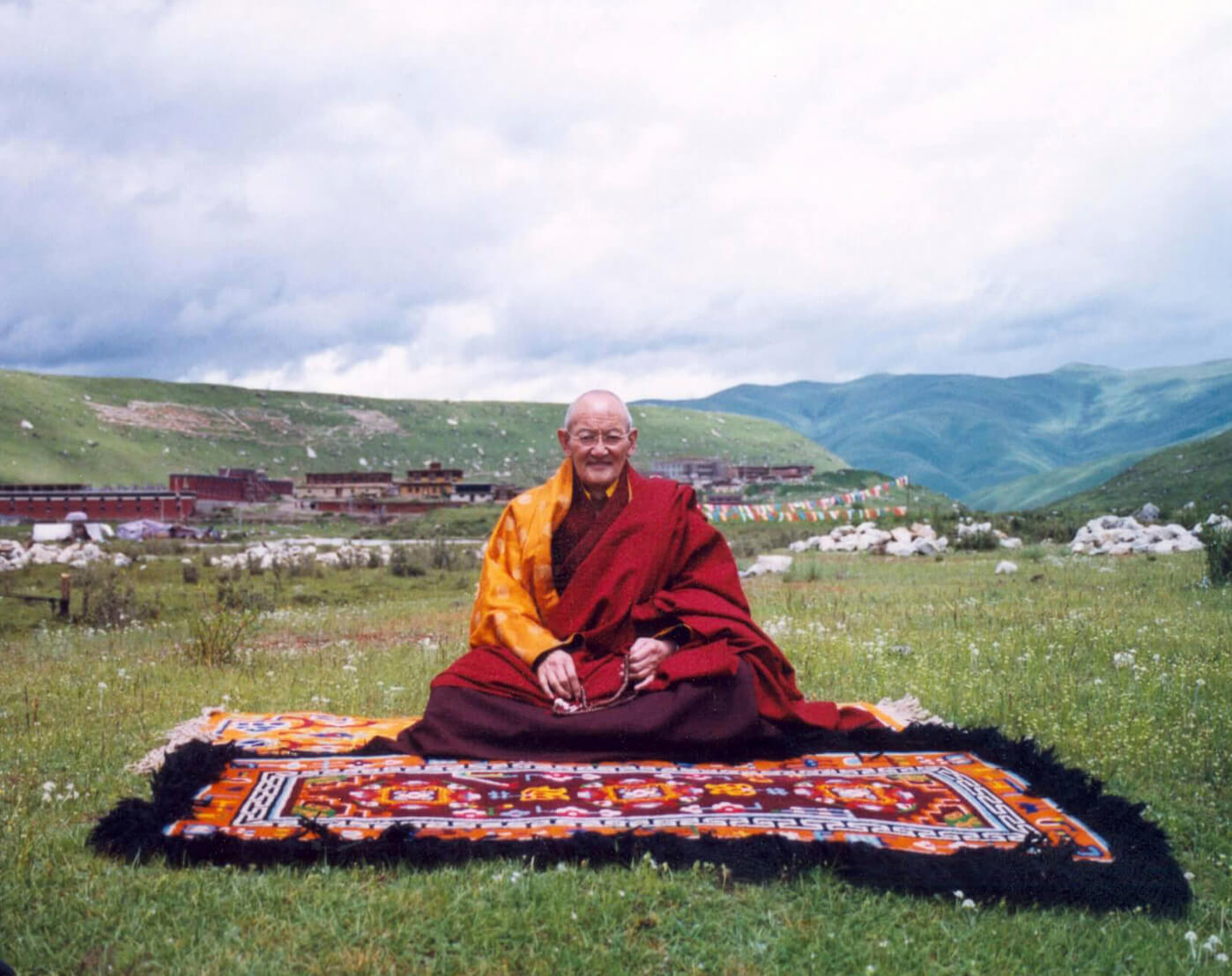
Drukpa Rinpoche
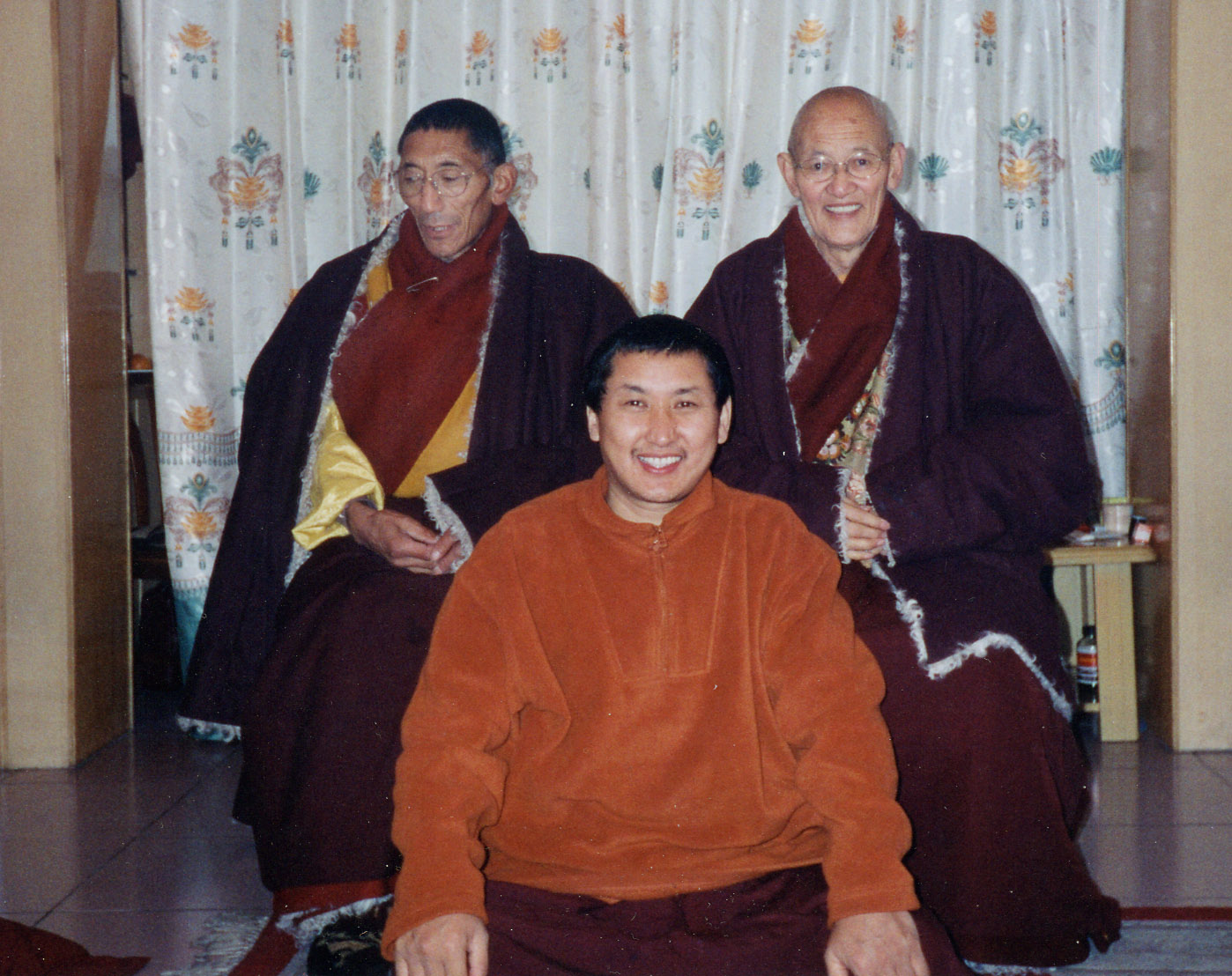
Drukpa Rinpoche, Tulku Orgyen Rinpoche, Patrul Rinpoche

Patrul Jigme Chökyi Wangpo (1808-1887)
Patrul Rinpoche Orgyen Jigme Chökyi Wangpo est né l’année du Dragon de la Terre du quatorzième Rabjung (1808), dans la vallée de Dzachuka, la région nomade de Golok au Tibet oriental. Il était l’incarnation de la parole de Rigdzin Jigme Lingpa et l’un des grands enseignants et écrivains Nyingma, ainsi que l’un des maîtres qui ont établi le mouvement non sectaire rimé. Il a travaillé sans relâche pour le bien des êtres sensibles, exposant le Dharma partout où il allait, et l’histoire de sa vie et ses écrits sont souvent cités par les érudits. De nombreux signes miraculeux ont entouré sa naissance.
Bien que reconnu officiellement comme tulku de Palge Samten Phüntsok par Dola Jigme Kalzang, il était un tulku de Jigme Lingpa. Le premier Dodrupchen a dit : « Je lui confie l’esprit et la transmission aspirationnelle de l’enseignement complet de Longchen Nyingthik, avec le nom d’Orgyen Jigme Chökyi Wangpo. »
Palge Könchok, neveu du dernier Palge, amenait Patrul Rinpoche à Palge Lastrang, la résidence du dernier Palge. C’est là qu’il commença ses études.
Sengtruk Pema Tashi, du monastère Dzogchen, l’ordonna comme moine. Avec Dola Jigme Kalzang, Jigme Ngotsar, Gyalse Shenpen Thaye et d’autres enseignants, il étudia la Trilogie pour trouver le confort et l’apaisement de Longchen Rabjam, la Voie du Bodhisattva (Bodhicaryāvatāra), le Tantra de l’Essence Secrète (Guhyagarbha) et de nombreux autres ouvrages liés aux sūtras et aux tantras, ainsi qu’aux sciences ordinaires. De Shechen Öntrul Thutob Namgyal, il a reçu la transmission de lecture des Paroles du Bouddha traduites (Kangyur) et des enseignements sur la grammaire du sanskrit. Il a reçu les transmissions du Kangyur et du Tengyur dans leur intégralité, ainsi que les écrits de nombreux maîtres de l’ancienne et de la nouvelle école de traduction.
Cependant, ses maîtres principaux étaient Jigme Gyalwe Nyugu et Do Khyentse. Il a reçu des instructions sur le ngöndro du Longchen Nyingthik environ vingt-cinq fois de la part de Jigme Gyalwe Nyugu et a accompli les pratiques requises le même nombre de fois. Plus tard, il a couché par écrit ces paroles de son maître sur le ngöndro pour en faire le célèbre texte Künzang Lame Shyalung (Le chemin de la grande perfection), un texte indispensable pour ceux qui cherchent à suivre la voie du Dharma, et qui est maintenant connu et lu par de nombreux pratiquants laïcs en Occident. En outre, il a reçu des instructions sur la pratique du tsa-lung et le Dzogchen, et a étudié de nombreux cycles de pratique que l’on trouve dans les écritures canoniques (ka’ma) du Vajrayāna Nyingma.
Un jour, Do Khyentse, qui errait en effectuant des exercices ésotériques, vint à la tente de Patrul, l’appela et l’introduisa avec force à sa nature éveillée. Patrul était déchiré par deux sentiments contradictoires : le choc de ses propres pensées négatives et l’émerveillement devant la clairvoyance de Do Khyentse. S’asseyant, il médita immédiatement sur la nature éveillée de son esprit et une conscience claire, ouverte, intrinsèque, semblable au ciel, surgit en lui. C’est alors que s’est éveillée en lui une réalisation claire et totale, comme un soleil levant, s’ajoutant à la réalisation semblable à l’aube qu’il avait déjà, suite à l’introduction qu’il avait reçue de Gyalwe Nyugu. À partir de ce moment, il utilisa le nom de ‘vieux chien’ comme nom ésotérique, comme Do Khyentse l’avait appelé en lui montrant la vraie nature de son esprit.
Lorsque Patrul avait environ vingt ans, Palge Könchok, l’administrateur en chef de Palge Lastrang, mourut. Patrul ferma la résidence de Palge et commença à vivre comme un ermite errant.
Tout en restant pendant de longues périodes près du monastère de Dzogchen, où il reçut les transmissions du Nyingthik Yabzhi et du Longchen Nyingthik du 4e Dzogchen Rinpoche et de Gyalse Zhenphen Thaye, il séjournait dans les ermitages isolés de Rudam, comme la grotte Yamantaka et la grotte de la Longue Vie. Il mettait toute son énergie dans la pratique de la méditation et atteignait une réalisation aussi vaste que l’espace.
Bien qu’il soit l’un des plus grands érudits de la tradition Nyingma, qui l’honora avec un siège élevé au sein de l’institution, il vivait comme un ermite des plus humbles et des plus simples. Errant dans les vallées de Ser, Do, Mar et Dzika, il donnait des enseignements sur le Bodhicaryāvatāra
et incitait toute la population à réciter ‘Om Mani Padme Hum’.
Ayant complètement réalisé la nature intrinsèque des phénomènes, il apparaissait sous l’apparence d’un simple mendiant. À un moment donné, alors qu’il voyageait, il rencontra un lama qui lui enseigna le ‘Chemin de la grande perfection’, le texte qu’il avait lui-même écrit. Manifestement, ce lama ne savait pas qui il instruisait et pensait que cet homme pourrait retirer des bienfaits d’un enseignement aussi extraordinaire.
Une autre histoire raconte qu’il voyageait avec une pauvre veuve. Il l’aidait à cuisiner et à s’occuper de ses enfants. Lorsqu’ils arrivèrent au village suivant, il s’excusa en disant qu’il avait quelque chose d’important à faire. La femme avait entendu dire que le grand Patrul Rinpoche enseignait au monastère. Lorsqu’elle est allée l’écouter, elle a été stupéfaite de voir le sympathique mendiant avec lequel elle avait voyagé, assis sur le trône et donnant des enseignements à une grande assemblée. Après l’enseignement, il a demandé que toutes les offrandes lui soient remises.
Il donnait des enseignements aux laïcs de toute stature dans la société, sans faire de distinction. De même, il s’adressait à ses interlocuteurs d’une manière directe, avec peu de politesses mondaines. Ses paroles pouvaient être rudes et honnêtes, surtout envers ses étudiants. Il parlait directement et fort, mais chacun de ses mots était une parole de vérité, de sagesse et de bienveillance.
Décrivant la personnalité de Patrul, le 3e Dodrupchen écrit :
« Patrul utilise des mots effrayants et excessivement durs, mais il n’y a aucune trace de haine ou d’attachement dans ces mots. Si vous savez les écouter, ils ne sont directement ou indirectement que des enseignements. Tout ce qu’il dit est solide comme de l’or – c’est vrai. Il traite tous les gens sur un pied d’égalité, sans les flatter en leur présence ni les calomnier en leur absence. Il ne fait jamais semblant d’être quelque chose ou quelqu’un d’autre. Ainsi, tout le monde, de haut ou de bas niveau, le respecte en tant qu’enseignant authentique. Il n’est pas partial à l’égard des personnes de haut rang, et il n’a aucun mépris pour les personnes ordinaires. Lorsque quelqu’un est impliqué dans des activités non vertueuses, à moins que la personne ne soit incapable de changer, il déterre immédiatement les fautes de cette personne et les expose. Il loue et inspire les personnes qui poursuivent une vie spirituelle. Il semble difficile à servir, mais aussi proche que l’on soit de lui, il est impossible de trouver en lui un seul exemple de malhonnêteté, de doute, d’instabilité ou d’hypocrisie. Il est d’une amitié immuable, et il est facile et relaxant d’être avec lui. Il a de la patience, que ce soit pour les bons ou les mauvais événements. Il est difficile de se séparer de lui. Bien qu’il soit resté un pratiquant caché toute sa vie, il est sain à tous points de vue, car il ne s’écarte jamais des activités de bodhisattva. Comme le dit un proverbe : « Même si l’or reste sous terre, sa lumière rayonne vers le ciel. » Dans la mesure où vous l’examinez, vous le trouverez propre et pur. Dans la mesure où vous pensez à lui, votre foi en lui augmente. »
Lors de ses pérégrinations, il préconisait l’abolition du système consistant à servir de la viande aux lamas lorsqu’ils venaient accomplir des services rituels, et il édictait des règles contre le vol et la chasse. Il a introduit le Dharma dans la vie de chacun et dans chaque foyer, de sorte qu’il n’était pas limité aux seuls moines et monastères. Les voleurs sauvages et les chasseurs cruels étaient apprivoisés par le pouvoir de sa présence et de ses paroles de vérité. Il a enseigné aux habitants de Marung, qui n’avaient pas encore appris les mots et encore moins leur signification, les mots de compassion ‘Om Mani Padme Hum’.
Après avoir erré pendant une dizaine d’années dans les vallées et les collines de Do et Ser, donnant des enseignements autour des sièges de Dodrupchen, Patrul retourna au monastère de Dzogchen. Il séjourna dans les ermitages de Padme Thang et de Nakchung, et au collège Śri Siṃha du monastère de Dzogchen. Pendant plusieurs années, il n’a cessé de faire tourner la roue du Dharma, enseignant sur les traités de Maitreya, la Voie du Milieu, l’Abhidharma, le Tantra de l’Essence Secrète, le Trésor des Qualités Précieuses, la Détermination des Trois Vœux et bien d’autres sujets encore.
Imprégné de la sagesse et de la compassion des bouddhas, ses paroles et ses actions étaient à tout moment orientées vers le Dharma. Sa seule préoccupation était de mettre les êtres sur la voie en exposant les paroles du Bouddha, les amenant ainsi à la lumière de la réalisation de la vraie nature de l’esprit, comme l’avaient fait les maîtres avant lui, en ligne ascendante directe :
- Samantabhadra
- Vajrasattva
- Garab Dorje
- Śri Siṃha
- Mañjuśrīmitra
- Jñānasūtra
- Vimalamitra
- Padmasambhava
- Trisong Detsen
- Berotsana
- Yeshe Tsogyal
- Longchenpa
- Jigme Lingpa
- Gyalwe Nyugu
- Patrul Rinpoche
Durant les dernières années de sa vie, Patrul a vécu autour de Dzagya Gon, le siège de son précieux maître-racine Gyalwe Nyugu. Il y établit une retraite annuelle de trois mois et un enseignement sur le Bodhicaryāvatāra. Il a également présidé un enseignement et une pratique d’une semaine sur la terre pure d’Amitābha, le Bouddha de la Lumière Infinie.
Il établit un centre d’enseignement à proximité du monastère de Dzagyal et répara le grand complexe de murs de pierres mani que son incarnation précédente Palge Samten Phuntsok avait construit. Ce lieu est connu sous le nom de Patrul Dobum.
Patrul Rinpoche n’acceptait presque jamais d’offrandes, et s’il en acceptait, il les envoyait immédiatement au fonds pour les murs de pierres mani. Avec juste assez de tsampa pour subvenir à ses besoins, il laissait souvent la nourriture qui lui était offerte là où elle se trouvait. Ainsi, les personnes pauvres qui le suivaient pouvaient recueillir les offrandes qu’il laissait derrière lui.
À l’âge de quatre-vingts ans, comme Do Khyentse l’avait prédit, il a commencé à avoir des problèmes de santé. Le 18e jour du 4e mois de l’année du cochon de feu (1887), il prit son thé du matin comme d’habitude. Puis, avant midi, il s’est assis nu dans la posture du Bouddha et a placé ses mains sur ses genoux. Son assistant et étudiant dévoué Khenpo Künpal essaya de lui remettre ses vêtements, sans aucune réaction. Patrul, qui avait les yeux ouverts dans un regard méditatif, fit claquer ses doigts une fois et reposa ses mains dans le mudra de la contemplation. À cet instant, son esprit se fondit dans la pureté primordiale. Le vingtième jour du mois, Tsamtrül Rinpoche accomplit la cérémonie pour réveiller l’esprit de Patrul de l’absorption.
Patrul Rinpoche n’avait laissé aucun objet de valeur. Il y avait un seul ensemble de vêtements de moine, un bol à aumônes, un châle jaune, un vêtement inférieur, de la nourriture pour une dizaine de jours, un ensemble de cinq textes d’Asaṅga et une copie du Madhyamakāvatāra, cinq pièces d’argent et quelques écharpes, à envoyer au fonds du mur de pierre. C’est tout ce que Patrul Rinpoche possédait. Il ne possédait pas de biens matériels, pas même beaucoup d’écritures, et les quelques-unes qu’il avait, il les donnait parfois parce qu’il les connaissait toutes par cœur. Il n’avait pas de papier ni de stylo en bambou. Où qu’il soit pendant ses pérégrinations, dès qu’il se levait, il était prêt à partir immédiatement.
Au cours de sa vie, Patrul Rinpoche a donné de nombreux enseignements sur les textes des sūtras, des tantras et du Dzogpa Chenpo. Il a éveillé la réalisation ultime dans l’esprit de nombreux disciples chanceux. En de très rares occasions, il a donné des transmissions de pouvoir tantriques ou organisé des cérémonies élaborées.
Son enseignement, ses écrits et sa pratique étaient non sectaires ; ainsi, il émula l’ensemble des traditions bouddhistes du Tibet.
Ses écrits qui ont été préservés sont rassemblés en neuf volumes, sur le Dzogpa Chenpo, les tantras, les sūtras, les conseils, la poésie et le théâtre. Mais malgré cette vaste collection de travaux profonds lui valant le statut d’un des plus grands érudits, il resta un yogi caché, suivant parfaitement l’exemple de son maître.
Il a laissé une empreinte profonde dans l’esprit et le cœur de ceux qui ont eu la chance de le rencontrer. Aujourd’hui encore, ses paroles résonnent et continuent de conduire les êtres vers l’essence même du Dharma du Bouddha.
Ouvrages cités :
Le Chemin de la Grande Perfection, Patrul Rinpoche, traduit par le groupe de traduction Padmakara. Extraits de l’introduction. ISBN 9782906949133
Master of Meditation and Miracles: Lives of the Great Buddhist Masters of India and Tibet, Tulku Thondup, Edited by Harold Talbott, Shambhala Publications, inc. Première édition en livre de poche 1996. Ouvrages cités : 201-210
Première réincarnation de Dza Patrul Rinpoche, sous le nom de Ranyak Patrul Rinpoche, 1892-1917
Le premier Ranyak Patrul Rinpoche est né en 1892, et selon le calendrier tibétain le 7e jour du 5e mois de la 15e année du dragon d’eau de Rabjung.
Le premier Ranyak Patrul Rinpoche a été déclaré l’incarnation de Dza Palge, ou Orgyen Jigme Chökyi Wangpo, par le grand 5e Dzogchen Rinpoche, Thupten Chökyi Dorje, qui l’a reconnu comme son propre lama racine.
Ranyak Drupchen Rinpoche, j’ai besoin de votre plus jeune fils car il est la véritable réincarnation de Dza Palge ou Dzogchen Patrul Rinpoche et, ayant confirmé sa renaissance, il sera placé sur le trône soutenu par les lions intrépides.
Patrul Rinpoche était né dans la famille des Ranyak. Il est né dans la région de Dzajut au Kham. Son père, Ranyak Gyalse, connu sous le nom de Ranyak Drupchen Rinpoche (1832-1909), était un être hautement réalisé. Non seulement il avait atteint le plus haut degré de réalisation dans la pratique du Dharma, mais il avait également un pouvoir sur la matière, avec la capacité de fendre les rochers et de ramener les animaux à la vie. Il a fait le serment d’accomplir la puja du Ganachakra en chantant 100 millions de fois le mantra de Guru Rinpoche. Découvrez l’incroyable histoire de la vie de Ranyak Drupchen Rinpoche.
Après avoir eu son quatrième enfant, il a dit à sa femme : « Il n’est pas bon pour un yogi d’avoir beaucoup d’enfants. Mais peut-être que cet enfant peut être utile aux êtres sensibles, n’est-ce pas ? Quoi qu’il en soit, l’enfant que tu portes maintenant sera mon dernier enfant. En examinant les signes issus de mes expériences de méditation et de mes rêves, cet enfant sera certainement la réincarnation d’un être saint. À la fin de sa vie, il est certain que cet enfant pourra bénéficier au Dharma et aux êtres sensibles. »
À la naissance du premier Ranyak Patrul Rinpoche, en 1892, son père a déclaré que le garçon aurait de nombreux obstacles à surmonter. Il s’est retiré pour réciter des mantras et faire des pratiques yogiques. Puis, au cours de ses méditations, il reçut un message selon lequel lui et son fils devaient se rendre à Dzogchen, dans la région du Kham. Ceux qui se trouvaient au monastère de Dzogchen se préparaient et les recevaient en grande pompe. À leur arrivée, le 5e Dzogchen Rinpoche demanda immédiatement une audience avec les parents et l’enfant.
Thupten Chökyi Dorje, le 5e Dzogchen Tulku, a dit :
« Drupchen Rinpoche, parmi vos fils et vos filles, votre fille aînée devrait être le successeur de votre famille. Votre plus jeune fille est une manifestation nirmanakya de la dakini Karma qui se nourrit de chair, et devrait donc devenir une nonne. Puisque votre fils aîné est l’incarnation de Shakor Tulku, quelqu’un viendra le rencontrer pour s’occuper de lui. J’ai dit que j’avais besoin de votre plus jeune fils parce qu’il est la véritable réincarnation de Dza Palge ou Dzogchen Patrul Rinpoche et, lorsque sa renaissance aura été confirmée, il sera placé sur le trône soutenu par les lions intrépides. »
Le premier Ranyak Patrul Rinpoche a terminé ses études à l’Université Shri Singha de Dzogchen. Il était doté de grandes qualités et de grands mérites. Il jouissait de la maîtrise complète de son esprit réalisé. Il se rendait plus tard dans la province d’Amdo, dans le nord-est du Tibet, pour y répandre les enseignements.
À l’âge de vingt-cinq ans, alors qu’il voyageait avec son entourage, une dispute éclata entre eux. Il leur a conseillé de résoudre le problème ou il les quitterait. Comme la situation ne semblait pas vouloir se résoudre, il prit congé. Il se retira pendant sept jours et ses disciples ne le revoyaient plus ; ayant fusionné avec la sphère de la réalité ultime, il avait atteint le corps arc-en-ciel. Il ne restait plus que ses cheveux et ses ongles. Son esprit est passé dans le dharmakaya le 25e jour du 4e mois de l’année du serpent de feu du 15e Rabjung ou, selon le calendrier occidental, en 1917.
Les cérémonies qui ont suivi ont été menées par son neveu Thupten et Shakor Tulku.
« Profond et paisible, sans pensée, lumineux, non créé,
Le nectar de la vérité, je l’ai découvert maintenant.
Si je devais l’enseigner, personne ne comprendrait,
Et donc je vais rester, sans parler, dans la forêt. »
Bouddha Shakyamuni, Lalitavishtara-sutra
La deuxième réincarnation de Patrul Rinpoche, 1937-1959
La deuxième réincarnation est née sous le nom de Tsedjal, près du lac bleu Kokonor dans le nord-est du Tibet en 1937. Sa mère était Pema Tsoshid, la nièce du 5e Dzogchen Rinpoche, Thupten Chökyi Dorje, et sa grand-mère maternelle Konsto était la sœur du premier Ranyak Patrul Rinpoche.
Jigtral Shongchup Dorje l’a reconnu sans l’ombre d’un doute et l’a intronisé comme la nouvelle réincarnation de Dzogchen Patrul Rinpoche. Dès son plus jeune âge, il a fait preuve de toutes les bonnes qualités d’apprentissage, de pureté et de compassion.
Malheureusement, sa vie s’est arrêtée à un jeune âge. Il a dit à sa sœur, Tsering Drolma, avec qui il avait un lien fort, qu’elle ne devait pas s’inquiéter et qu’il reviendrait bientôt. Son esprit éveillé s’étant tourné ailleurs, il s’est éteint en 1959.
Tsering Drolma épousa un homme nommé Drupa, et trois ans plus tard, elle eut son deuxième enfant avec lui. L’enfant a été reconnu comme la présente et troisième réincarnation de Dza Patrul Rinpoche.
